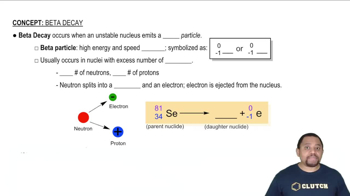Textbook Question
Complete and balance the following nuclear equations by supplying the missing particle: (b) 21H + 32He → 42He + ?
1
views

 Verified step by step guidance
Verified step by step guidance



Complete and balance the following nuclear equations by supplying the missing particle: (b) 21H + 32He → 42He + ?
Complete and balance the following nuclear equations by supplying the missing particle: (d) 12253I → 12254Xe + ?
Complete and balance the following nuclear equations by supplying the missing particle: (a) 147N + 42He¡? + 11H
Complete and balance the following nuclear equations by supplying the missing particle: (d) 5826Fe + 2 10n¡6027Co + ?
Complete and balance the following nuclear equations by supplying the missing particle: (e) 23592U + 10n¡13554Xe + 2 10n + ?